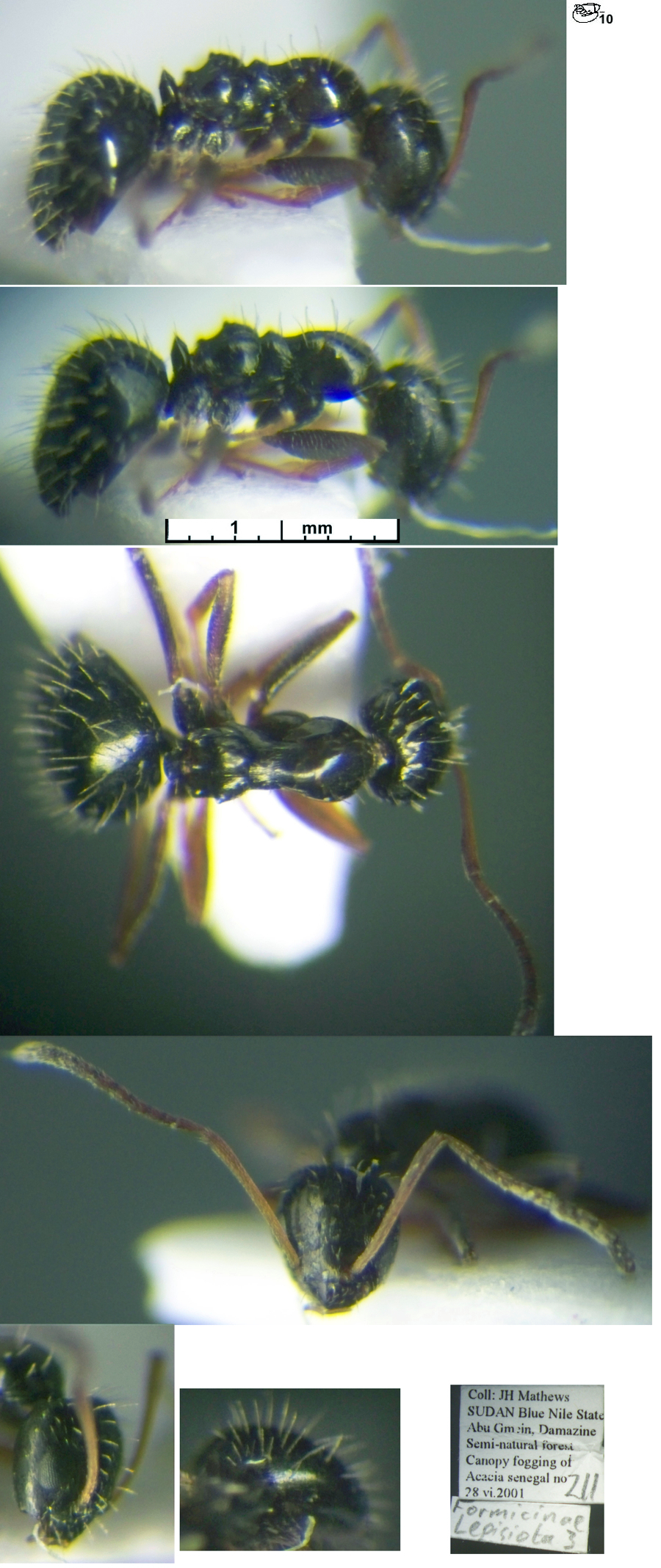Lepisiota canescens (Emery)
  Type location Somalia
(Acantholepis capensis Mayr, var. canescens n. var.,
Emery, 1897e: 601,
worker) Coromma, Lago Abaja; also Sciotel, Beccari - see below Type location Somalia
(Acantholepis capensis Mayr, var. canescens n. var.,
Emery, 1897e: 601,
worker) Coromma, Lago Abaja; also Sciotel, Beccari - see below
subspecies latior (Acantholepis
canescens Emery v. latior
n. v., Santschi, 1935a: 268, worker) from Zaïre, N'gazi,
Elskens - see http://www.antweb.org/specimenImages.do?code=casent0912372
unavailable
name anodon (Acantholepis
(Acantholepis) capensis Mayr st. canescens Em. v. anodon n. var., Santschi, 1933b:
107, worker) from Kenya - no images on Antweb (October
2014)  . .
|
Emery's (1897e) description is at  . Smaller, TL 2.0-2.5, and petiole with
blunter teeth than capensis. Santschi's (1933b) description of anodon
is at . Smaller, TL 2.0-2.5, and petiole with
blunter teeth than capensis. Santschi's (1933b) description of anodon
is at  . .
|
Listed from locations across sub-Saharan Africa by
Wheeler (1922); these included Senegal (Dakar, F. Silvestri), Guinea
(Kindia, F. Silvestri), Ghana (Aburi, F.
Silvestri) and Nigeria (Lagos, F. Silvestri).
Wheeler described it (as a subspecies of capensis)
as a form with long, white pilosity and abundant pubescence
"distributed throughout the Ethiopian Region". In Zaïre, Mr. Lang found
the nest in dirt in the axils of cut leaves of oil palms. There seem to
be strong similarities with my Lepisiota
validiuscula.
Collingwood (1985), who described a number of genus
members from Saudi Arabia, commented that is small, black and shining;
separable (from Arabian species) by having the antennal scape only
slightly longer than the HW, overreaching the occiput by a third or
less of its length; head and gaster smooth and brilliant; whole dorsum
thickly clothed with pale hairs; adding it has widely spaced broad
propodeal teeth and a moderately indented petiole - differing from capensis
by its smaller size, finer pilosity and absence of propodeal sculpture.
Bernard (1952) described it as one of the most common
species of all Africa, found close to water, even in desert oases; in Guinea
[by assumption] it did not seem to occur in primary forest, but was
abundant in savanna, rarer on the mountain crests between 1300 and 1600
m.
Not reported from Egypt but quite likely in, at least, southern areas.
|
 The photomontage of a worker listed in the type
description is collated
from http://www.antweb.org/specimen.do?name=casent0905153 The photomontage of a worker listed in the type
description is collated
from http://www.antweb.org/specimen.do?name=casent0905153
|
 The
photomontage is of a specimen from Congo, Réserve de
Lésio-Louna, S 03°21'23.1" E 015°29'51.2"; 6-9.ii.2008; n sp 65;
pitfall trap 13, t 3; Village Mah; collected by Eric Zassi. The
photomontage is of a specimen from Congo, Réserve de
Lésio-Louna, S 03°21'23.1" E 015°29'51.2"; 6-9.ii.2008; n sp 65;
pitfall trap 13, t 3; Village Mah; collected by Eric Zassi.
|
 The
photomontage is of a specimen from Benin; Collection
details - Forêt de Gbèvozoumè, 06°55’32.8 N 02°29’13 E; lisière fourmis
(forest edge/ border ants); 28.ii.2007; S Tchibozo. The
photomontage is of a specimen from Benin; Collection
details - Forêt de Gbèvozoumè, 06°55’32.8 N 02°29’13 E; lisière fourmis
(forest edge/ border ants); 28.ii.2007; S Tchibozo.
|
 The
photomontage is of a specimen collected in Sudan, Ar
Roseris, 11°50'60"N 34°22'60"E; by Awatif Omer, 2009. The
photomontage is of a specimen collected in Sudan, Ar
Roseris, 11°50'60"N 34°22'60"E; by Awatif Omer, 2009.
|
 The photomontage is of a worker from Sudan,
collected by J Mathews, by pyrethrum fogging of Acacia senegal,
semi-natural forest, Abu Gmein, Blue Nile, 11°21' N 34°27' E,
28.vi.2001, JM 211. The photomontage is of a worker from Sudan,
collected by J Mathews, by pyrethrum fogging of Acacia senegal,
semi-natural forest, Abu Gmein, Blue Nile, 11°21' N 34°27' E,
28.vi.2001, JM 211.
|
|